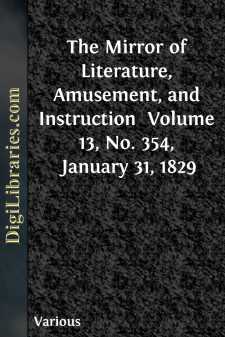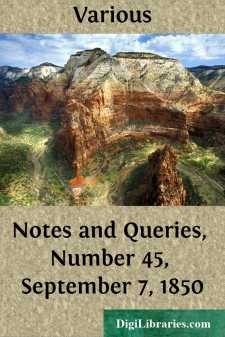Categories
- Antiques & Collectibles 13
- Architecture 36
- Art 48
- Bibles 22
- Biography & Autobiography 813
- Body, Mind & Spirit 142
- Business & Economics 28
- Children's Books 17
- Children's Fiction 14
- Computers 4
- Cooking 94
- Crafts & Hobbies 4
- Drama 346
- Education 46
- Family & Relationships 57
- Fiction 11829
- Games 19
- Gardening 17
- Health & Fitness 34
- History 1377
- House & Home 1
- Humor 147
- Juvenile Fiction 1873
- Juvenile Nonfiction 202
- Language Arts & Disciplines 88
- Law 16
- Literary Collections 686
- Literary Criticism 179
- Mathematics 13
- Medical 41
- Music 40
- Nature 179
- Non-Classifiable 1768
- Performing Arts 7
- Periodicals 1453
- Philosophy 64
- Photography 2
- Poetry 896
- Political Science 203
- Psychology 42
- Reference 154
- Religion 513
- Science 126
- Self-Help 84
- Social Science 81
- Sports & Recreation 34
- Study Aids 3
- Technology & Engineering 59
- Transportation 23
- Travel 463
- True Crime 29
The Mirror of Literature, Amusement, and Instruction Volume 13, No. 354, January 31, 1829
by: Various
Categories:
Description:
Excerpt
THE COLOSSEUM, IN THE REGENT'S PARK.
In a recent Number of the MIRROR we offered ourselves as the reader's cicerone throughout the interior of this stupendous building, the exterior of which is represented in the annexed engraving; and the architectural pretensions of which will, we trust, be found of equal interest to the interior.
The Colosseum is what is termed a polygon of sixteen sides, 130 feet in diameter. Each angle is strengthened by a double square pilaster of the Doric order, which supports an entablature, continued round the whole edifice. Above the cornice is a blocking course, surmounted by an attic, with an appropriate cornice and sub-blocking, to add to the height of the building. The whole is crowned with a majestic cupola, supported by three receding scamilli, or steps, and finished with an immense open circle. The upper part of the cupola is glazed, and protected with fine wire-work, and the lower part is covered with sheet copper; which distinctions are shown in the engraving.
When the spectator's surprise and admiration at the vastness of the building have somewhat subsided, his attention will be drawn to the fine and harmonious proportions of the portico, considered by architects as one of the best specimens of Graeco-Doric in the metropolis. This portion of the building is copied from the portico of the Pantheon at Rome, "which, in the harmony of its proportions, and the exquisite beauty of its columns, surpasses every temple on the earth." Altogether, the grandeur and effect of this vast structure should be seen to be duly appreciated.
The adjoining lodges are in exceedingly good taste; and the plantations laid out by Mr. Hornor, are equally pleasing, whilst their verdure relieves the massiveness of the building; and in the engraving, the artist has caught a glimpse of the lattice-work which encloses the gardens and conservatories attached to the splendid suite of rooms. The front is enclosed by handsome iron rails, tastefully painted in imitation of bronze. We ought also to mention, that the means by which the portico is made to resemble immense blocks of stone, is peculiarly successful.
The architect of this extraordinary building is Mr. Decimus Burton, aided by his ingenious employer, Mr. Hornor, of whose taste and talents we have already spoken in terms of high commendation. Its original name, or, we should say, its popular name, was the Coliseum, evidently a misnomer, from its distant resemblance to that gigantic work of antiquity. The present and more appropriate name is the COLOSSEUM, in allusion to its colossal dimensions; for it would not show much discernment to erect a building like the Pantheon, and call it the Coliseum. The term Diorama has, likewise, been strangely corrupted since its successful adoption in the Regent's Park—it being now almost indefinitely applied to any number or description of paintings.
SNEEZING AMONG THE ANCIENTS.
(For the Mirror.)
Among the Greeks, sneezing was reckoned a good omen. The practice of saluting the person who sneezed, existed in Africa, among nations unknown to the Greeks and Romans....












